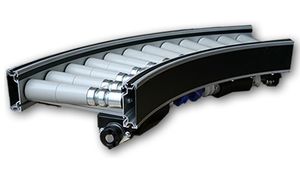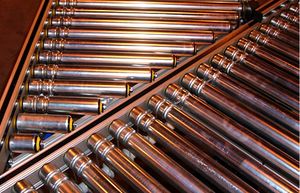Lineshaft Roller Conveyors
Lineshaft Roller Conveyors are, as their title suggests, powered via a shaft beneath the rollers. These conveyors are suitable for light applications up to 20 kg such as cardboard boxes and tote boxes. A single shaft runs below the rollers running the length of the Conveyors. On the shaft there are a series of spools; one spool for each roller. A rubber o-ring runs from a spool on the powered shaft to each roller. When the shaft is powered the rubber o-ring acts as a chain between the spool and the roller making the roller rotate. The rotating of the rollers pushes the product along the conveyor. The shaft is usually driven by an electrical motor, which is generally controlled by the an electronic PLC. A PLC (Programmable Logic Controller) electronically controls how specific sections of the conveyor system interact with the products being conveyed. Advantages of this conveyor are quiet operation, as well as easy installation and maintenance. They can be manufactured for almost all applications, at relatively low expense. A disadvantage of the roller lineshaft conveyor is that it can only be used to convey certain produce. Items conveyed have to be of adequate size and shape so that they cannot fall between the moving rollers. If the product being conveyed is of varying size, theconveyor belt system is generally used as an alternative option.
Advantages
- Capable of powering over 100 feet of straight sections, curves and many other accessories with one motor, therefore reducing the high costs of power consumption, installation and maintenance.
- Ideal for transportation, minimum back pressure and accumulation, zero pressure accumulation and sortation of boxes, cases or totes in medium to light duty applications.
- Line pressure can easily be reduced in the field by removing or reversing the urethane drive belts at specific intervals, or by installing zones of roller brakes or blade stops.
- The modular design of Lineshaft roller conveyor allows for quick, low-cost change overs enabling customers to modify their systems to meet future needs.
- Moving parts are guarded and clearly labeled, and bearings are greased for life. Slippage of the drive spools enables personnel to stall rollers out by simply applying pressure to the roller.
- Lineshaft roller conveyors are quiet. Fewer motors decrease the sound of the drive chain, and belt tension on the rollers keep the roller axles from rattling in the axle holes.
- With 1.9 diameter or 1.4 diameter rollers on varying centers, Lineshaft roller conveyor can accept a wide variety of product sizes.
Limitations
- Lineshaft roller conveyor should not be used at excessively slow speeds. Rollers will easily stall out at slow speeds, especially with heavier products.
- Oily or wet conditions will impair the frictional drive characteristics of the conveyor.
- Lineshaft roller conveyor should not be used for inclines. Maximum allowable incline is 1°, or 2” per 10 foot section.
- Plow arms should not be used for diverting product on lineshaft roller conveyor. Products will tend to jam and accumulate.
- Products need a flat bottom surface to transport effectively on the conveyor rollers.
- Be cautious when running lineshaft roller conveyor at temperatures less than 35°F or at temperatures greater than 100°F.Extreme temperatures will decrease the life of the urethane drive belts.
- Do not use lineshaft roller conveyor in applications where corrosive or abrasive substances are present. Contact with these substances will damage the various components of the conveyor.Do not skew rollers at angles greater than 5° unless the skewed section consists of a very short portion of a longer intermediate section. If rollers are skewed, consider a low friction guard rail.

